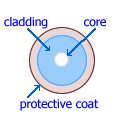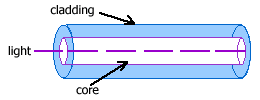Networking Guide : Physical Media - Fiber Optic

Picture: Fiber optic structure
Fiber Optic (optical fiber) is
a thin glass or plastic strand in the core which is surrounded by
a cladding and a protective coat and is used to carry information
in
optical (light) pulses. Because in fiber optic, information is
transmitted in optical pulses instead of electrical signals, fiber
optic is not affected by EMI (electromagnetic interference) and
RFI (radio frequency interference). Moreover, fiber optic has
very large bandwidth which is limited only by
the equipment that lights the fiber (i.e. SDH/SONET,
ATM, DWDM).
But fiber optic is more expensive than twisted pair, coax and
radio.


Picture: single-mode fiber (left) and multimode
fiber (right)
Fiber optic is often classified into single-mode and
multimode. In a single-mode fiber, light travels in one path
(mode). In a multimode fiber, light travels in multiple paths
(multimode). Single mode fiber can reach longer distance than
multimode fiber, so it is mostly used for MAN or
WAN. While
multimode fiber is suitable for implementing high speed
LAN.
Because of its reliability and wider bandwidth, fiber optic is often used in backbone networks where
cables run in ducts and in broadband networks that deliver
bandwidth intensive applications, such as HDTV,
video streaming, video conferencing and Video on Demand.
|